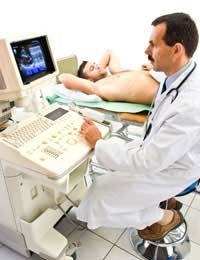All About Echocardiography

An echocardiogram is a method used to look at the heart and its structures. It is based on an ultrasound scan and allows practitioners to make a closer examination of the inside of the heart, including the chambers and valves. Using highly technical equipment, high frequencies are passed through the tissues to allow for an ultrasound image to be transmitted to a screen and the working heart can be seen as a 2 dimensional image.
Why Do I Need an Echocardiogram?
Most people who have been asked to attend an appointment for an echocardiogram will have been referred by their GP who suspects a diagnosis of heart disease. It can measure the size and shape of the heart, allow visualisation of any abnormalities and measures its overall strength and function.This type of scan is also very useful in diagnosing heart conditions in the newborn infant as it is not invasive and does not cause pain. Scans taken via the external chest wall also need little co-operation as long as the patient remains still.
Using the ultrasound scanning technique, the valves can be seen in great detail, and allows the specialist to see if there are any problems with the flow of blood through the chambers and valves of the heart.
Types of Echocardiography
There are two main approaches used to carry out an echocardiogram, transthoracic and transoesophageal.Transthoracic Approach
This involves the placement of an ultrasound probe directly onto the external chest wall. This approach is totally painless and non-invasive. It is the usual method of achieving echocardiography and is used to make a fast and precise examination of the overall function of the heart.
Transoesophageal Approach
Slightly more invasive, this requires the passing of a very small probe into the oesophagus in order to achieve a more detailed look at the heart including the valves and the side of the heart facing away from the chest wall.
Many practitioners will often try and examine the heart using the transthoracic approach initially, but if the valves cannot be seen or other structures are obstructing the view, they will often proceed to the transoesophageal approach.
What To Expect
The test will be performed by either a trained sonographer or by the cardiologist themselves, depending on the facilities offered by the hospital and whether the use of sedation is needed, such as with a transoesophageal echo.Both types of procedure should be painless, though a tranoesophageal scan does carry some discomfort. Nerves and discomfort are usually alleviated by the use of sedation and local anaesthetic throat spray, if the patient requires it.Before the probe can be placed on the chest wall, a jelly-like substance will usually be applied to the area, which is useful for transmitting clearer images.
The actual scans should take no longer than ten or fifteen minutes and are very important to allow the specialist to make an accurate diagnosis and plan an appropriate treatment schedule.
Ultrasound scanning techniques have proved to be extremely valuable in modern medicine, allowing doctors to make exact diagnoses without the need of risky surgical techniques. When diagnosing and treating diseases of the heart and vascular system, it has proven to revolutionise the way in which heart disease patients are managed and allows them a more positive outlook as diagnosis can be made early and treatment plans designed in line with the individual patient’s needs.
- Natiuretic Peptides and Heart Failure
- What Are Cardiac Biomarkers?
- CT Scan Screening for Heart Disease
- Carotid Duplex Scanning
- What is an Electrocardiogram (ECG)?
- Having a Chest X-ray
- CT Scans and MRI Scans
- What is a Pulse Oximeter?
- What is an Exercise Test?
- What is a Transoesophageal Echocardiogram?


Re: Laser Surgery for Coronary Artery Disease
I was diagnosed with Idiopathic Pulmonary Fibrosis (IPF) four years ago. For over two years, I relied on…
Re: Coronary Angioplasty Surgery
My husband had a stent put in at the beginning of January. It was done at a government hospital and the doctors appointment is…
Re: Hole in the Heart: What Happens Next?
I was just in hospital with left side pain and numbness was diagnosed with hole in heart I’m home now and I’m having…
Re: Hole in the Heart: What Happens Next?
Ok I'm 61 yes old.ive been in 3 motorcycle wrecks,I have sticky platelets I've been hospitalized 3:times with blood…
Re: Why Does My Heart Beat Faster After Sweet Food?
The coffee doesn't make a heart beat faster. Caffeine makes the hart beat harder/stronger. The sugar…
Re: Hole in the Heart: What Happens Next?
Hi Doctor, My friend is having 35 years and he is having a hole in the heart, he consulted many doctors in USA and…
Re: What is Heart Block?
Hello. I have born first degree heart block. 10 years ago was temporarily changing to 2 degrees, but stay first degree. Am I at high risk…
Re: Hole in the Heart: What Happens Next?
In Sept '16 I was diagnosed with hypertension (high blood pressure) and in May '17 I had a stroke - the only symptoms…
Re: Hole in the Heart: What Happens Next?
Hi Iam 53 years old and living very healthy life. I have blood pressure but it is in normal condition with proper…
Re: What is Heart Block?
Hi there I had a pacemaker fitted last year for Mobitz II heart block. My pacemaker is set to fire if my rate drops below 60 b/pm. Am I…